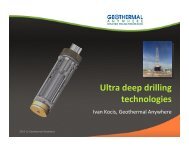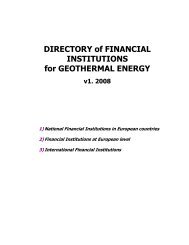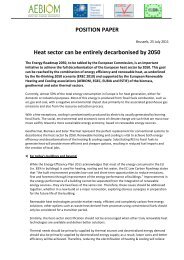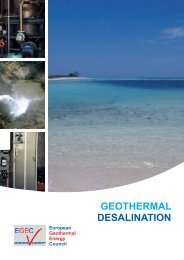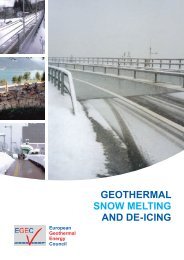4<strong>Strategic</strong> <strong>Research</strong> <strong>and</strong> <strong>Innovation</strong> <strong>Agenda</strong> <strong>for</strong> <strong>Renewable</strong> Heating & CoolingRHC applications <strong>and</strong> priorities <strong>for</strong> non-residential buildingsST.6ST.7<strong>Research</strong> <strong>and</strong> <strong>Innovation</strong> PrioritiesMultifunctional building components, including façade<strong>and</strong> roof integrated collectors, <strong>for</strong> new <strong>and</strong> existing buildingsHighly efficient solar assisted cooling systems combiningheating <strong>and</strong> coolingPredominanttype of activityImpactDevelopment By 2020Development By 2020ST.8 Solar based hybrid systems <strong>for</strong> 100% renewable heat solutions <strong>Research</strong> By 2030ST.9 <strong>Research</strong> on new absorption <strong>and</strong> adsorption chillers <strong>Research</strong> By 2030Table 7: research <strong>and</strong> innovation priorities <strong>for</strong> solar thermal applications to non-residential buildings4.3 Biomass technologiesThere are a variety of biomass boiler technologies available to provide energy <strong>for</strong> heating <strong>and</strong>sanitary water to the service sector at very competitive costs. Rated thermal loads <strong>for</strong> theservice sector range from a few tens of kW up to the low MW range. Wood chips, pellets <strong>and</strong>other locally available biomass residues are applicable as fuels. The boilers are installedeither as single boiler solution or in cascades. When implemented in bi- or multivalent installations(these are installations using multiple energy carriers), biomass boilers are usuallyproviding the base load energy supply <strong>for</strong> economic reasons.For applications requiring a couple of 100 kW <strong>and</strong> smaller scaled rated loads, CHPs arepotentially interesting <strong>and</strong> economically feasible technology options if a reasonable numberof operating hours is achieved. Also, biomass-based cooling with absorption <strong>and</strong> adsorptionchillers are viable technology options.Capital costs biomass heat plants EUR/kWCapital costs biomass heat plants EUR/kW1000 1000800 800600 600400 400200 2002008 2008 2010 2010 2012 2012 2014 2014 2016 2016 2018 2018 2020 2020 2022 2022Domestic Domestic (12 (12 kW kW th ) th )Small Small commercial (100-200 (100-200 kW kW th ) th )Large Large commercial (350-1,500 kW kW th ) th )Small Small industry industry (100-1,000 (100-1,000 kW kW th ) th )Large Large industry industry (350-5,000 kW kW th ) th )%%25 2520 2015 1510 105 50 01990 1990 1995 1995 2000 2000Figure 28: potential evolution of capital costs <strong>for</strong> biomass heat plants (adapted from IEA 2012b)25 25EUR cent/kWhEUR cent/kWh20 2015 1510 105 52010 2010 2020 2020100 100Temperature (˚C) (˚C)50 500 08-16 8-16EUR/GJ EUR/GJDomestic Domestic6-12 6-12 4-9 4-9 4-9 4-94-9 4-9EUR/GJ EUR/GJ EUR/GJ EUR/GJ EUR/GJ EUR/GJ EUR/GJ EUR/GJSmall Small commercial Large Large commercial Small Small industry industry Large Large industry industry(100-200 (100-200 kW) kW) (350 (350 - 1,500 - 1,500 kW) kW) (100 (100 - 1,000 - 1,000 kW) kW) (350 (350 - 5,000kW) - 5,000kW)0 01870 1870 1920 1920Figure 29: Biomass heat production costs in 2010 <strong>and</strong> 2020 (adapted from IEA 2012b)44100 100 200 2002010 2010High High temperatureheat heat (>400˚C) (>400˚C)60% 60%
<strong>Renewable</strong>Heating & CoolingEuropean Technology Plat<strong>for</strong>m4.3.1 <strong>Research</strong> <strong>and</strong> innovation priorities with impact in the Short TermAs biomass technologies covering the heat <strong>and</strong> sanitary water dem<strong>and</strong> of the servicesector become increasingly competitive, more demonstration projects are needed tocreate confidence <strong>and</strong> to spur Europe-wide diffusion. The main challenges are in the development<strong>and</strong> demonstration of cost-efficient <strong>and</strong> energy-efficient system concepts, whichmake use of different technologies <strong>for</strong> RHC in bi- or multivalent (hybrid) systems. Intelligentsystem design <strong>and</strong> effective heat storage are key priorities <strong>for</strong> efficiencyimprovements. Another core element is the development of integrated, plug & play controltechnology optimised <strong>for</strong> the integrated use of other renewable energy technologies <strong>and</strong>relevant components.Whilst the above is mostly related to cross-cutting topics, the main challenges related onlyto biomass technology are the development of cost-effective solutions to reducedust emissions <strong>and</strong> the development of small scale CHPs.BIO.6ObjectiveCost effective solutions to reduce dust emissionsIn order to overcome the tightening of air quality requirements, secondary measuresto reduce dust emissions will be required in the future. There<strong>for</strong>e, reliable <strong>and</strong> cost-effectivePM abatement technologies <strong>for</strong> applications of roughly 100 to 500 kW th are to be developed<strong>and</strong> demonstrated. These can either be fabric filters, electrostatic precipitators (ESPs) orscrubbers <strong>and</strong>/or condensers.Whilst sophisticated combustion systems <strong>for</strong> high-quality fuels should be able to withst<strong>and</strong>tighter air quality requirements with primary measures only, combustion of lower grade woody,non woody, RDF <strong>and</strong> pre-treated fuels will require the use of secondary measures.Their application must be able to show a clear economic trade off between increasedinvestments <strong>and</strong> fuel cost savings.State-of-the-artTargetsPM abatement technology is state-of-the-art <strong>for</strong> biomass plants of 500 kW nominalthermal loads <strong>and</strong> more. Typical investment costs <strong>for</strong> existing PM abatement technologiesare about 1/3 of the total investment costs of the biomass plant. For the thermal load rangeof 100 to 500 kW, there are no proven economically viable technologies available so far.Several technologies (bag house filters, fabric filters, ESPs, scrubbers) are under development<strong>and</strong>/or under demonstration, or just appearing on the market now. No technology hasreached successful commercialisation so far.Technological goals are to reliably achieve clean gas concentrations complying with therelevant air quality requirements with a successful decoupling of abatement technology<strong>and</strong> boiler per<strong>for</strong>mance, <strong>and</strong> a maintenance-free operation.In order to become viable technology options, investment costs have to be reduced byroughly 25%. To do so, new production technologies <strong>for</strong> serial production of PM abatementtechnology is necessary.Type of activity40 % Development / 60% DemonstrationBIO.7ObjectiveCogeneration technologies <strong>and</strong> small scale biomass gasification technologiesThe objective is to develop <strong>and</strong> demonstrate technologically reliable <strong>and</strong> economicallycompetitive cogeneration technologies in an electric nominal power range of roughly 10to 250 kW electric. The technological options to be validated are Stirling engine, steam engine,ORC, <strong>and</strong> externally fired gas turbines based on biomass combustion, as well as internalcombustion engines (IC) or small-scale gas turbines using syngas from biomass gasification.Whilst <strong>for</strong> the combustion-based concepts it will be crucial to develop heat transfer conceptsthat avoid deposit <strong>for</strong>mation on <strong>and</strong> fouling of heat exchangers, syngas quality will be crucial<strong>for</strong> the success of gasification-based cogeneration concepts. The latter will require the furtherdevelopment of small-scale gasification concepts <strong>and</strong> the development of cost-effective syngascleaning technology to overcome tar problems. Applicable fuels range from wood pellets <strong>for</strong> thesmaller scale technologies, up to low grade wood chips or even locally available non-wood orpre-treated biomass fuels derived from waste streams <strong>for</strong> the technologies on the upper electricoutput range considered.For the demonstration stage applications allowing <strong>for</strong> an expected required minimum of5,000 hours of full load operation <strong>and</strong> a higher tolerance regarding different fuel qualitiesmust be identified. Heat use <strong>for</strong> heating purposes or <strong>for</strong> thermal cooling must be ensured.State-of-the-art So far, only IC concepts using biogas <strong>and</strong> / or biodiesel are commercially available in theconcerned scale. Solid biomass-based cogeneration technologies are not commerciallyavailable yet. Several concepts, based both on biomass combustion as well as on gasificationare under development however no technological breakthroughs have been achieved inrecent years.Targets Economic viability <strong>and</strong> cost competitiveness without the need of subsidies by 2020(assuming reference oil price of 100$ per barrel)Type of activity 25% <strong>Research</strong> / 50% Development / 25% Demonstration45



